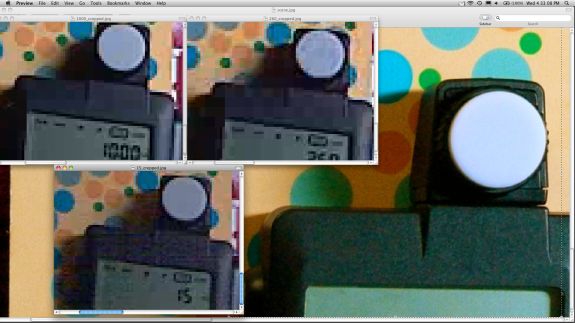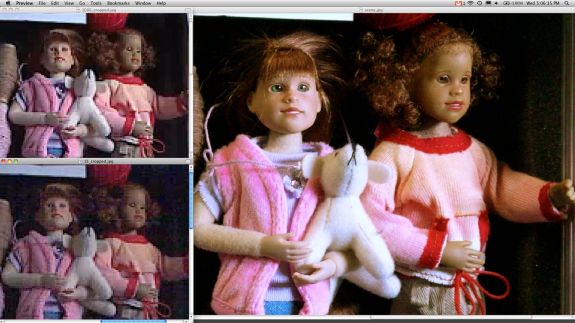Dropcam Echo : Home Security Meets the Cloud
by Ganesh T S on August 11, 2010 7:50 AM EST- Posted in
- Gadgets
- IP cameras
- camera
- camcorder
It has been quite some time since AnandTech reviewed cameras or camcorders for their image and video quality. Even amongst professional gadget review sites, there is an absence of a standardized benchmarking methodology for this purpose. Starting with this review, we have decided to use the Handsome Case for evaluating image and video capture gadgets. This kit can be used to determine and analyze many image and video quality characteristics. However, this section will only deal with factors relevant to a security camera in a home setting.
It is very important for any security camera to have a good performance in low lighting conditions. We performed a quick image quality test of the Dropcam at various light intensity levels. The light temperature was held constant at 5500 K and three light levels were evaluated: 1000 lux, 260 lux, and 15 lux. The evaluation was not extensive and did not included moving objects or resolution measurements. In general, the camera held up well under low light conditions in this static scenario.
One interesting thing is the choice of holding color saturation levels somewhat constant under lower light conditions. Chroma noise becomes prominent at 15 lux, especially noticeable in dark low frequency areas. It is our understanding that most industrial security applications make the design decision to reduce chroma as light intensity falls or simply to move to black and white mode at a given light intensity. The typical security professional would prefer less noise or more color to maintain resolution and detail. Since this is a consumer targeted unit we believe they made the right decision as most consumers likely prefer to see color and will accept the tradeoff of chroma noise. That being said, it might be nice to have a "black and white mode" or some configurability in this area for the discerning low light viewer.
Again, no detailed analysis was performed on the resultant bitstream but the smaller block sizes present in the lower lux scenes seems to indicate that more bits are being used to encode these scenes as the encoder will need to work harder to encode the increased noise patterns.
In Figure 6A, note the low frequency dark area of the color meter. As light intensity is decreased this area contains more noise - especially in the chroma plane. The encoder interprets the noise as detail that needs to be encoded. We don't know the internal workings of the image pipeline, but a 3D noise filter that identifies spatial noise patterns over time would certainly help here. Such filters are present in most of the present day IP camera chipsets. So, future models are likely to have improvements in this area.
In Figure 6B, note the red feather in the scene captured at high lux with a DSLR compared to the screen shots of the unit encoding at 1000 Lux and 15 Lux. The unit loses most of the fine detail at 1000 lux and then works much harder in the lower lux environment likely because a moving noise pattern is present and this noise is attempting to be encoded.
The human eye is trained to look carefully at faces. In Figure 6C, some degradation of the facial resolution is noticeable between 1000 lux and 15 lux, but skin tone is maintained nicely. Note the difference in chroma noise in the low frequency dark area behind each doll.
To summarize the DSP qualities, it can be said that the unit holds up well under differing low light conditions. Chroma levels are maintained with the resultant artifacts noticeable. More configuration options would be nice for low light scenes but the target audience is probably going to be happy with the tradeoffs in the shipped unit.














24 Comments
View All Comments
vgribok - Thursday, August 12, 2010 - link
Security camera footage is just one kind of data generated by households that one wants to make accessible on the web in a secure, authenticated manner while not having to tinker with routers, IPs and such. Real problem is that it's very hard to create any web-based application that is easy enough for a non-technical person to install, and yet secure enough to expose it on the web. That's why there are very few redistributable web applications for consumers and small businesses, while large corporations moved to web based apps long time ago.An ability to build easily-redistributed web-based applications that can be installed inside LANs but still be securely exposed on the web without making non-techy people fiddle with routers, DNS, etc. is the idea being implemented by UltiDev HttpVPN (http://www.httpvpn.com/). It will be paired with Apple-like application store allowing creation and distribution of web applications for customers with no technical skills required to setup secure web hosting on premises, like consumers and small businesses. Home surveillance systems would be a perfect example of who would use HttpVPN.
ipvideomarket - Saturday, August 14, 2010 - link
Dropcam has dozens of competitors with more mature offerings delivering cloud native solutions.For instance, Axis has over 12 partners world-wide supporting Axis's Video Hosting Service.
Also, contrast to Viaas who is delivering a more sophisticated end to end solution.
Finally, a free 'cloud integration' service is offered by Lorex providing no-cost live video monitoring at half the up front cost of Dropcam.
Lonbjerg - Saturday, August 14, 2010 - link
Who in their right mind still thinks a MAC filter gives any form of security?It's spoofed in less than a second...madre mia :/
Anyone still using MAC filtering should turn in their network-man-card.
xtian78h - Tuesday, August 17, 2010 - link
I'm NOT associated with this company before I'm accused of shameless plugging, but given the subject matter I'm surprised no-one has mentioned viaas.com (Video Intelligence As A Service). It looks to be similar to Dropcam.Key differences appear to be - that Dropcam has audio support & iphone monitoring (big plus) - The Viaas cameras come with a micro SDHC slot which allows for the loss of internet connectivity and a can also provide a buffer allowing the user to impose bandwidth / traffic shaping over DSL etc. Other challenges with Viaas - no iphone support.. lack of UK presence (pricing).
Whilst some will doubtless argue, why do you need UK pricing, it's a cloud service after all. When you start shipping cameras from the US and need to guestimate import duty, VAT etc - it just becomes tedious. Likewise with fluctuating exchange rates - services billed only in dollars can rapidly start adding up.